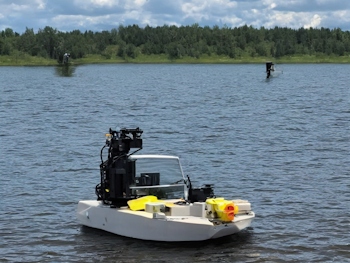Karaburan
| Project Karaburan | |
|---|---|

| |
| Monitoring water quality | |
| Status | Initializing |
| Contact | bertrik |
| Last Update | 2024-07-07 |
Next steps
- write python scripts
- arduino turbidity
- turbidity-to-mqtt
- hook things into systemd / udev
- e.g. insert GPS -> create symlink with udev -> trigger (re)start of gpsd
- analoog in op de pi:
- UPS voor pi: https://elektronicavoorjou.nl/product/raspberry-pi-ups-hat/
- 1-wire stuff:
- 1-wire adapter emulation on an stm32: https://github.com/alitekin2fx/stm32_ds2480_emu
- owfs.org for easy interfacing with multiple 1-wire devices in a hierarchical way on linux
Experimental stuff
USB HID as analog input
- Can I program an STM32 as a USB HID device, and model analog inputs as USB HID sliders/knobs, possible even with meaningful units/ranges?
- directly recognised by linux kernel without a specific driver, or running some other protocol over emulated serial
See also https://github.com/vostrenkov/EazyJoy
influxdb
See https://hub.docker.com/_/influxdb
See https://github.com/bertrik/karaburan/tree/master/influxdb
investigate RTK GPS
Goal: figure out if it is practically possible to achieve cm resolution with a 200-euro GPS and a free correction service: YES
- https://www.nsgi.nl/referentiepunten-en-gnss-data/gnss-data/real-time-streams public correction data service
- https://www.ardusimple.nl/rtk-in-5-minutes/
- RTK in action https://www.youtube.com/watch?v=Oc1LBFDj2MA
- Use with Linux / gpsd: https://stackoverflow.com/questions/77314115/drotek-gpsd-and-ntrip-correction-data-for-precise-positioning ?
- Chipsets
- Quectel LC29H, see https://rtklibexplorer.wordpress.com/2024/04/28/dual-frequency-rtk-for-less-than-60-with-the-quectel-lc29hea/
- uBLOX ZED-F9P
- Boards
- UM980 / UM982
Edit /etc/default/gpsd, set GPSD_OPTIONS:
GPSD_OPTIONS="-Gn ntrip://user:pass@ntrip.kadaster.nl:2101/CBW100NLD0"
Option -G exposes the control socket on all network interfaces, option -n keeps the GPS active if there is no one currently connected.
Plotting live location on a map:
- Configure gpsd to expose its socket to the outside world: last section of https://gpsd.gitlab.io/gpsd/troubleshooting.html
- In QGIS, press ctrl+0 to show the GPS information tab, enter the name of the remote gpsd (port 2947)
Station at Stolwijk (close to Gouda): https://gnss1.tudelft.nl/dpga/station/Stolwijk.html#STWK ?
Introduction
Topics:
- air quality sensors
- ammonia
- NOx
- water chemical analysis
- nitrates
- ammonia
- dissolved oxygen
- sulfide/sulfate
- phosphates?
- salinity (chlorides?)
- water physical analysis
- temperature
- clarity/turbidity -> investigate standard ways of measuring/expressing this
- conductivity/total dissolved solids
- water properties by light reflection, hyperspectral/polarity
- depth?
- boat control
- trajectory -> steering
- idea: interface with the remote control, not with the boat
- idea: find a boat with easily hackable remote control protocol
- idea: can we get sensor data over this link too, e.g. GPS?
- camera control
- post-processing
- data presentation
- video/photo stitching
- time lapse view
- map view of properties
- data presentation
- use cases
- verify with domain experts, how to engage?
- slootview, under/above water
- minimum viable prototype
- high-res measurement by location, by time
- materials
- boat selection
- processing platform selection
- communication platform selection
Air quality sensors
Nitrogen compounds in air
According to https://www.rivm.nl/stikstof/monitoren-advies-onderzoek/overzicht-stikstofmetingen/metingen-stikstof-in-de-lucht average (typical?) values of
- Ammonia (NH3): 6.7 ug/m3 (9.6 ppb)
- NOx: 27.3 ug/m3
- NO2: 18.6 ug/m3 (9.9 ppb)
(ppb-conversion using https://www.breeze-technologies.de/blog/air-pollution-how-to-convert-between-mgm3-%C2%B5gm3-ppm-ppb/ )
RIVM report on inexpensive nitrogen-in-air sensors: https://www.samenmeten.nl/sensoren-voor-no2 Conclusion: most sensors are not sensitive enough to be used in typical outdoor conditions, with perhaps one exception: alphasense NO2-B43F
Water physical analysis
Turbidity / clarity
See https://en.wikipedia.org/wiki/Turbidity
Aliexpress sensor TS-300B: https://nl.aliexpress.com/item/1005006732956937.html Has a range 0 ~ 1000 ± 30 NTU
Order of magnitude for turbidity:
- Drinking water upper limit: 4 NTU (European turbidity standard for drinking water)
- Ambient water: 10-150 NTU. The US state of Washington use a "background" value of 50 NTU as reference.
(see https://en.wikipedia.org/wiki/Turbidity#Standards_and_test_methods )
So the Aliexpress sensor is suited only for "dirty" water.
Boat control
Typically the wireless link looks like this:
- 2.4 GHz working frequency
- 500m range
Interesting links:
- Flytec-2011 remote control https://nl.aliexpress.com/item/1005002984723718.html
- Replacement board for various boats with "18" in their type number: https://nl.aliexpress.com/item/1005006115484716.html
- DIY Multi-protocol module: https://github.com/pascallanger/DIY-Multiprotocol-TX-Module
remote control
Image of remote control RF chip: [...]
Parts:
- 12.000 MHz crystal/oscillator
- 16-pin control chip: 20_CL6L071
- 6-pin RF chip: 1110 / VKA3, could be an rx/tx switch, amplifier or filter circuit
See also: https://www.open-tx.org/
Next steps:
- map out the connections between the mainboard and the rf board, expected: VCC, GND, spi ?
Use cases
material:
- https://www.youtube.com/watch?v=cMk0bGvIU1E
- https://iplo.nl/thema/water/oppervlaktewater/kaderrichtlijn-water
- kaartje: https://krw-nutrend.netlify.app/ -> 2 meetpunten op de reeuwijkse plassen, tijdresolutie is 1 jaar?
Useful distinction, typically used in documents/guidelines:
- chemical quality, what substances are present in the water?
- biological / ecology quality, what kind of living organisms live in the water?
Reeuwijkse plassen
See
- https://www.rijnland.net/wat-doet-rijnland/in-uw-buurt/reeuwijkse-plassen/ their stated goal: CLEAR WATER
- https://www.rijnland.net/regels-op-een-rij/subsidies-en-andere-financi%C3%ABle-bijdragen/
potential applications:
- inspect water sides (oever) over time
- underwater camera: detect invasive cray fish
- sample water properties at high spatial resolution, high time resolution
- early detection of indicators for cyanobacteria: temperature and nutrients
Detect/find pollution source
- ...
Implementation
reading temperature sensor
The idea is to to use a DB18B20 temperature sensor, read it using an arduino nano board acting as a 1-wire adapter. Use openwire-fs as user-side openwire software http://owfs.org
Preparation:
- Add the regular user to the 'dialout' group, so it can access serial ports
sudo adduser <name> dialout
Setting up the hardware:
- connect the DS18B20 to the connector board with the pull-ups
- wire the connector board to the arduino nano, see ...
- plug the arduino nano in the pi
Setting up the software:
- Install openwire fs
sudo apt install owfs
- Create the openwire fs mountpoint
sudo mkdir /mnt/1wire
- Configure owfs, edit /etc/owfs.conf
server: device = /dev/ttyUSB0 mountpoint = /mnt/1wire allow_other (comment out the line with the FAKE devices)
- Configure systemd services
sudo systemctl enable owserver owhttpd sudo systemctl disable owftpd
- Start the systemd service
sudo systemctl start owserver owhttpd
- Check the logs
sudo journalctl -xeu owserver -f
- Open a browser to view the web interface
http://localhost:2121 or http://raspberrypi.local:2121